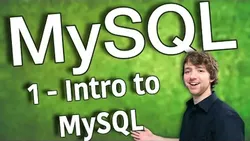
MySQL 2017 
This course provides an introduction to MySQL, including installation, MySQL Workbench, and beginner terms. It also covers one-to-one relationships, one-to-many relationships, and many-to-many relationships. It is designed to help users understand the basics of MySQL and how to use it effectively. ▼
ADVERTISEMENT
Course Feature
![]() Cost:
Cost:
Free
![]() Provider:
Provider:
Youtube
![]() Certificate:
Certificate:
Paid Certification
![]() Language:
Language:
English
![]() Start Date:
Start Date:
On-Demand
Course Overview
❗The content presented here is sourced directly from Youtube platform. For comprehensive course details, including enrollment information, simply click on the 'Go to class' link on our website.
Updated in [February 21st, 2023]
What does this course tell?
(Please note that the following overview content is from the original platform)
MySQL 1 - Intro to MySQL.
MySQL 2 - Installing MySQL.
MySQL 3 - MySQL Workbench.
MySQL 4 - Beginner Terms Part 1.
MySQL 5 - Beginner Terms Part 2.
MySQL 6 - Beginner Terms Part 3.
MySQL 7 - One-to-One Relationship.
MySQL 8 - One-to-Many Relationship.
MySQL 9 - Many-to-Many Relationship.
MySQL 10 - Summary of Relationships.
MySQL 11 - Entity Integrity.
MySQL 12 - Referential Integrity.
MySQL 13 - Domain Integrity.
MySQL 14 - Primary Key.
MySQL 15 - Auto Increment (AUTO_INCREMENT).
MySQL 16 - Foreign Key.
MySQL 17 - ON DELETE and ON UPDATE.
MySQL 18 - Intro to Normalization.
MySQL 19 - 1NF.
MySQL 20 - 2NF.
MySQL 21 - 3NF.
MySQL 22 - Normalization Summary.
MySQL 23 - Intro to Data Types.
MySQL 24 - Important Data Types.
MySQL 25 - CHAR Data Type.
MySQL 26 - VARCHAR Data Type.
MySQL 27 - TEXT, TINYTEXT, MEDIUMTEXT, LONGTEXT.
MySQL 28 - ENUM.
MySQL 29 - SET Data Type.
MySQL 30 - INT Data Type.
MySQL 31 - DECIMAL Data Type.
MySQL 32 - FLOAT and DOUBLE Data Types.
MySQL 33 - Datetime, Date, Time Data Types.
MySQL All-in-One Quick Concepts Tutorial Series (3 HOURS!).
We consider the value of this course from multiple aspects, and finally summarize it for you from three aspects: personal skills, career development, and further study:
(Kindly be aware that our content is optimized by AI tools while also undergoing moderation carefully from our editorial staff.)
1. Introduction to MySQL
Learners can obtain an introduction to MySQL, including the basics of the database management system, its features, and its uses. They will also learn about the different types of databases and how to install MySQL. Additionally, they will gain an understanding of the MySQL Workbench, which is a graphical user interface for managing databases.
2. Beginner Terms
Learners can gain an understanding of the basic terms used in MySQL, such as one-to-one, one-to-many, and many-to-many relationships. They will also learn about entity integrity, referential integrity, and domain integrity. Additionally, they will learn about primary keys, auto increment, and foreign keys.
3. Normalization
Learners can gain an understanding of normalization, which is the process of organizing data in a database. They will learn about the different normalization forms, such as 1NF, 2NF, and 3NF. Additionally, they will learn about the importance of normalization and how it can help improve the performance of a database.
4. Data Types
Learners can gain an understanding of the different data types used in MySQL, such as CHAR, VARCHAR, TEXT, TINYTEXT, MEDIUMTEXT, LONGTEXT, ENUM, SET, INT, DECIMAL, FLOAT, and DOUBLE. They will also learn about the Datetime, Date, and Time data types. Additionally, they will learn how to use these data types to store data in a database.
5. All-in-One Quick Concepts Tutorial Series
Learners can gain an understanding of all the concepts covered in the course in a short amount of time. They will learn about the basics of MySQL, beginner terms, normalization, data types, and more. Additionally, they will learn how to use the MySQL Workbench to manage databases.
[Applications]
After completing this course, MySQL 2017, participants should be able to apply their knowledge to create and manage databases, understand the different types of relationships between tables, and use the various data types available in MySQL. They should also be able to normalize data and use the primary key, foreign key, and auto increment features. Additionally, they should be able to use the MySQL Workbench to create and manage databases.
[Career Paths]
Three job positions recommended to learners of this course are:
1. MySQL Database Administrator: MySQL Database Administrators are responsible for the installation, configuration, maintenance, and security of MySQL databases. They must have a strong understanding of database design, data modeling, and SQL queries. As the demand for data-driven applications increases, the need for experienced MySQL Database Administrators is expected to grow.
2. MySQL Developer: MySQL Developers are responsible for developing and maintaining applications that use MySQL databases. They must have a strong understanding of database design, data modeling, and SQL queries. As the demand for data-driven applications increases, the need for experienced MySQL Developers is expected to grow.
3. MySQL Consultant: MySQL Consultants are responsible for providing advice and guidance to clients on the best way to use MySQL databases. They must have a strong understanding of database design, data modeling, and SQL queries. As the demand for data-driven applications increases, the need for experienced MySQL Consultants is expected to grow.
Course Provider

Provider Youtube's Stats at AZClass
Over 100+ Best Educational YouTube Channels in 2023.
Best educational YouTube channels for college students, including Crash Course, Khan Academy, etc.
AZ Class hope that this free Youtube course can help your Mysql skills no matter in career or in further education. Even if you are only slightly interested, you can take MySQL 2017 course with confidence!
Discussion and Reviews
0.0 (Based on 0 reviews)
Explore Similar Online Courses

The 50 Most Popular Linux & Terminal Commands - Full Course for Beginners

Introduction to linear equations and matrices

RDBMS PostgreSQL

Intro To PostgreSQL Databases With PgAdmin For Beginners

PostgreSQL: Client Applications

Mastering SQL using Postgresql

Database Design and Basic SQL in PostgreSQL

PostgreSQL: Advanced Queries

Spatial SQL with Postgres : A language for geographers

Learn SQL Using PostgreSQL: From Zero to Hero

PostgreSQL Essential Training


Start your review of MySQL 2017